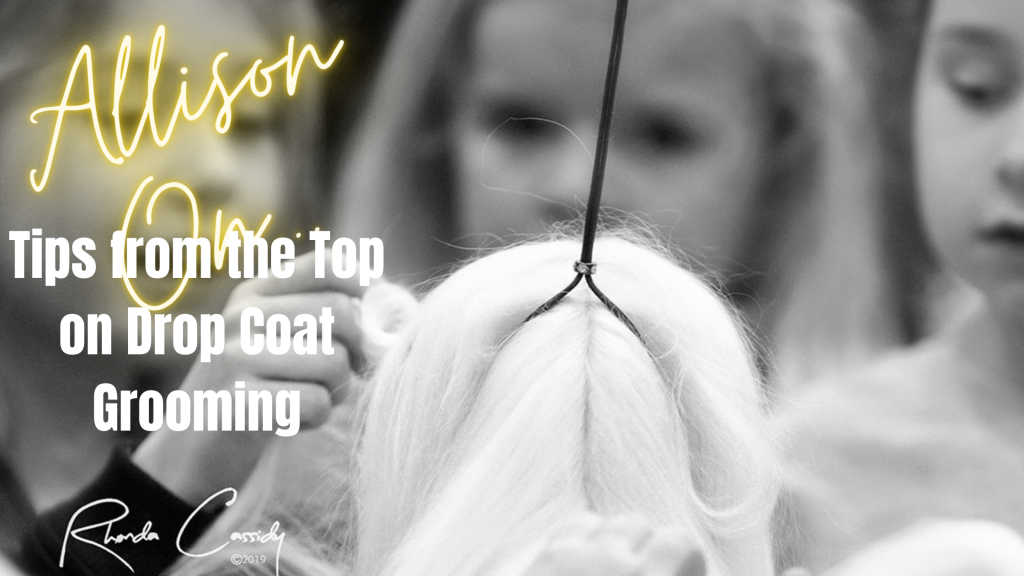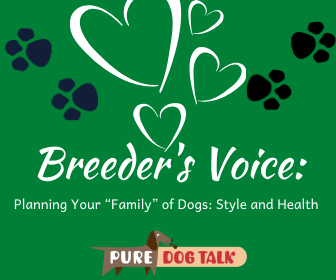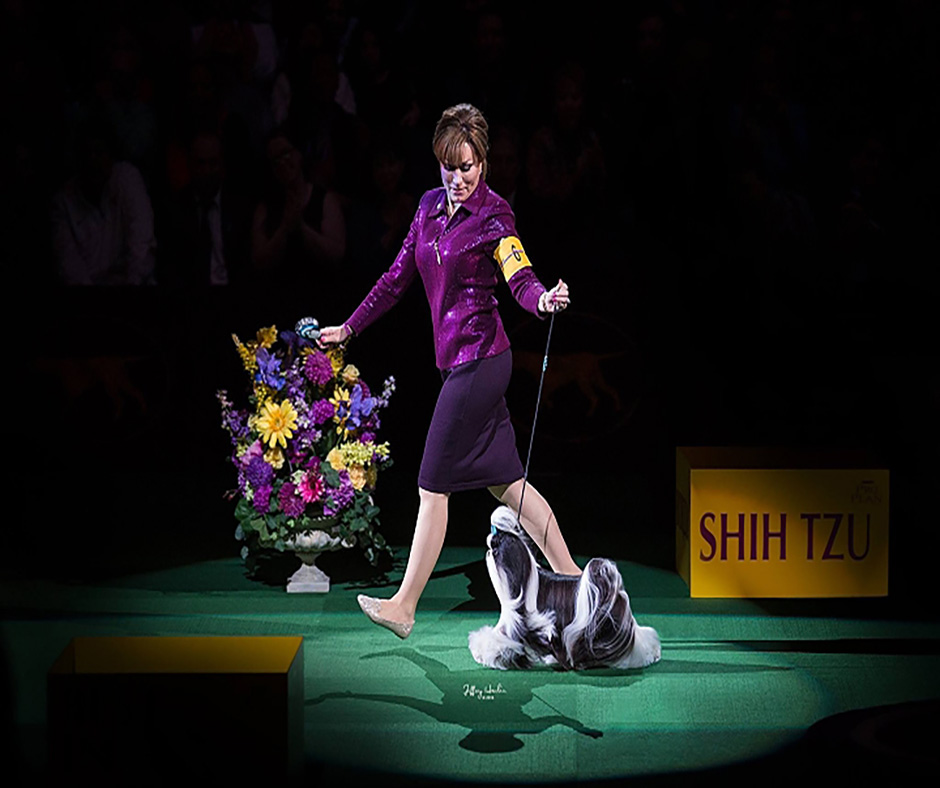465 – Allison On: Tips from the Top on Drop Coat Grooming
Allison On: Tips from the Top on Drop Coat Grooming
Allison Alexander, founder of Leading Edge Dog Show Academy and President of the Canadian Professional Handlers Association, joins host Laura Reeves to talk about grooming drop coated breeds, from maintenance to polish.
Allison’s years of experience provide enormous insight into the maintenance on coated breeds from a Maltese to a Briard. Along with professional tips on the tools of the trade…. What kind of pin brush, what type of wraps, HOW to wrap and band. We cover it all right here. Read on for just the tip of the iceberg. And click to listen to the entire fabulous conversation.
“Obviously the basics start with line brushing,” Allison said. “And one thing I will say about drop coats, and people might disagree with me, but drop coats more than any other coat type, you can’t have a bad day.
“Even a poodle in full show coat, you can skip a bath. They could get wet in a rainstorm or snowstorm and it’s midnight and you’ve driven for two days to get home and, I’m not recommending it, but you can let them get away with like towel him dry, sleeping it off overnight and starting the next day. You have a long coat, especially as single-coated long coat, and you do not have those options.
“So the commitment is like times 10 to me. There are no days off. So when it comes to line brushing to me to keep a really fully coated drop coat breed in coat, line brushing has to be something that you’re doing every day. You’re going to change those wraps every day. You’re going to change that topknot every day. You’re going to make sure that they look perfect.
“When it comes to line brushing, my kind of general rule of thumb is, the longer the coat the more coat they have, the longer the pin in the pin brush. When it comes to a single-coated drop coat, I’m going to use a brush with a slightly softer pad firmness. The double-coated drop coats, I’m going to use a brush that has a slightly firmer pad that the pins go in.
“We also know that no matter what we’re brushing, but again more important for long coats, never, ever brush the coat dry. You need some kind of brushing spray, whether it’s a brushing spray that’s just cutting down on static, whether it’s one that’s adding some kind of conditioner to the coat or whether it’s a detangling brushing spray. But they cannot be brushed dry. You’ll just keep snapping those ends off.
“When I am line brushing, I like to teach my dog to lay down on their side. Especially a drop coat because obviously, with that longer outer coat hanging down, you’re not going to get underneath. So if you’re drop coated dog is standing up, even if it’s a Skye terrier, even if it’s a Briard, how are you going to hold all of that coat up out of your way. You’re not going to be able to do that. So the first thing you can do is teach your dog to lay down on the table.
“Remember that our grooming tables are fabulous, they have non slip surfaces, but they are not the thing that our dog really wants to lay on. When I’m laying my dogs down to be line brushed, they typically have maybe a yoga mat, a grooming mat or like a thin dog bed, at the very least a nice thick bath towel underneath them. Mine typically have some kind of grooming mat and then a nice thick bath towel underneath them so that they’re comfortable. ‘Cause you’re going to be here for awhile.
“You’re going to start at the very shortest hair like as far down on the belly as you can and then I like to take the sections when I’m line brushing… so line brushing actually means going line by line through the coat… you have to create those lines. So, you’re creating those lines, typically you could use a knitting needle. I like to use a plastic rat tail comb. Some people use a metal rat tail comb, some people get really good at using their fingers.
“I like to go about a finger width between each line ’cause sometimes people are lined brushing but they’re using like 3 inches of code at a time and wondering why they’re not getting the same results so a fingers width. Obviously like on a little dog like a Maltese it probably would be my little finger and probably on a bigger dog like a Skye terrier, a Briard, it would be like a bigger finger.
“You’re going to take a layer coat, you’re going to mist it with whatever your brushing spray is, brush it with your pin brush, check it with your comb. We’re not using our comb to groom the dog because otherwise you’re going to be removing too much coat. We’re using the comb to check that we did get all the way down to the skin from one end of that line that we did (to the other.)
“Typically I’m going to go from the belly to the top line. Then I’m going to do each leg in the same manner. I don’t typically do the legs or the tail or the neck at the same time. I go from the armpit to the loin area all the way up from the belly. Then I’m going to the front leg from the bottom of the foot up. Back leg, under the tail, the tail, then the neck. It’s in sections. An it’s line by line by line.”
397 — Planning Your “Family” of Dogs: Style and Health
Planning Your “Family” of Dogs: Style and Health
Our topic is breeding. With an emphasis on planning your family of dogs. The question: is consistency of style more important than consistency of health and/or quality? How do you get to your desired goals?
Today’s guests are Amanda Kelly, Wendy Paquette and Chris Heartz. This is part one of a two part series. Check back next week for part two!
Type to type
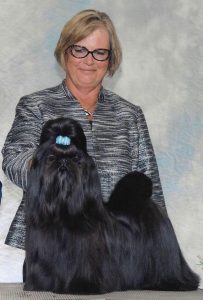 Wendy: “Coming from a background of Shih Tzu, that were only recognized in United States in 1969, I didn’t have much choice when I first started my breeding program. Living in northern Ontario, the only way I could buy a female was to import two from England ’cause they were just not available. Luckily I came across Luc Boileau in Montreal who was showing English imported dogs at the time. So I was able to take my English import and breed it to one of Luc’s dogs. But that left me sort of in a quandary because I had nowhere else to go after that. So I basically started out breeding type to type.
Wendy: “Coming from a background of Shih Tzu, that were only recognized in United States in 1969, I didn’t have much choice when I first started my breeding program. Living in northern Ontario, the only way I could buy a female was to import two from England ’cause they were just not available. Luckily I came across Luc Boileau in Montreal who was showing English imported dogs at the time. So I was able to take my English import and breed it to one of Luc’s dogs. But that left me sort of in a quandary because I had nowhere else to go after that. So I basically started out breeding type to type.
“Consistency of type was a goal, but health and welfare, to me, is a major factor. If you don’t have health and welfare you don’t have quality and type either.
“I have done inbreeding, outcrossing, line-breeding. I’ve done it all throughout the years. It’s easier to do stuff like that if you have quantity of dogs. So there was a point where I had up to 50 Shih Tzu. So I could pick and choose what direction I wanted to take each line.”
Health in a small gene pool
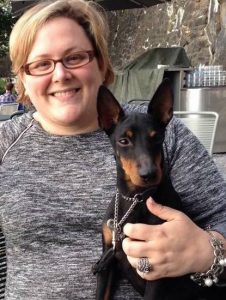 Amanda: “I think it depends on where your breed is. Every breed is going to be unique. How you approach setting up your own breeding program and also thinking about management of the population as a whole. So there’s a lot of things that come into play in that respect.
Amanda: “I think it depends on where your breed is. Every breed is going to be unique. How you approach setting up your own breeding program and also thinking about management of the population as a whole. So there’s a lot of things that come into play in that respect.
“As breeders, when we talk about getting consistency and cultivating aspects of breed type, we’re often talking about eliminating genetic material. In order to concentrate the genes so that we can get the head that we like or the coat that we like, we’re limiting the genes for the other things.
“(In) very small breeds, we have to not only think about what we want in our own breeding program, but also what is the best choices to make in order to cultivate the things that we think our breed needs now or may need in the future.
Cookie cutters
 Chris: “I sometimes get upset when I put a dog on the table and somebody who I maybe don’t know looks at me and says ‘Another cookie cutter.’ And it drives me crazy because I think of how many disappointments, how many hurdles we had to cross (to get our) cookie cutter right.
Chris: “I sometimes get upset when I put a dog on the table and somebody who I maybe don’t know looks at me and says ‘Another cookie cutter.’ And it drives me crazy because I think of how many disappointments, how many hurdles we had to cross (to get our) cookie cutter right.
“I was lucky enough that instead of a diamond, my husband gave me a dog as an engagement present. That dog was everything we wanted. He wasn’t perfect, but he was where we felt the breed needed to go. He had beautiful shoulders. He had reach and drive. He had a body shape that was not so common because he was actually short backed. We knew the blueprint but we made some mistakes and made some assumptions along the way.
“I have it in big bold letters: if you own a stud dog, he is not always the best breeding for your bitch. It took a long time to figure that out. I see people do it all the time. You have to know what clicks, what doesn’t click and what never to breed together.”
85 – Wendy Paquette on Shih Tzu, Toys and Breeding Challenges
Wendy Paquette – Shih Tzu, Toy Breeds and Breeding
Wendy Paquette faced challenges with her choice of Shih Tzu as a breed. Before the internet, with no other breeders in northern Canada, Wendy imported her first two dogs from England.
All Breed Judge and former Professional Handler, Wendy handled many of the toy breeds with multiple Best-in-Show success.
Smart Solution to Toy Breeding Education
Wendy had a smart solution to acquire a toy breed “Breeding” education, despite Canadian isolation.
She leased bitches from her top clients and whelped different toy breed litters! Firsthand she gained breed insight from day 1 in the whelping box.
Nigel Aubrey Jones
Nigel Aubrey Jones, great Pekingese breeder and author, was an influential mentor for Wendy.
Tips and Thoughts on Toys and Drop Coated Breeds
Health and Maintenance
Tend to be maintenance and care intensive for health and coat. Since they are small, owners tend to have larger numbers. The drop coats make it more difficult to notice health issues.
Lack of Exercise
Need more exercise than just an ex-pen. Despite the small size, they need to run outdoors, in fresh air, where they can stretch and tone muscle. Proper coat has strong hair, but some show dogs might need the sides tied up.
Temperament
Toys are companions and temperament is a must.
Wendy’s Thoughts
Learn the past of your breed. Know who the breeders were or are, and their contributions. Just because they don’t have a top dog out today, doesn’t mean the decades of knowledge and experience are any less.
Wendy has been involved in purebred dogs since 1971. She began her career breeding Shih Tzu, and along the way has owned and bred Samoyeds, Afghans, Salukis, Whippets, Brussels Griffon, Maltese, Pekingese, Lakeland Terriers and Wire Fox Terriers. She specializes in Shih Tzu and Lakeland Terriers as her main breeds and has produced over 250 Canadian Champions, 80 American Champions, 16 different Best In Show winners and 10 National Specialty winners. Wendy is a co-owner of Wenrick Kennels Incorporated. The Wenrick Shih Tzu breeding program is world-renowned.
Wendy is also a retired professional dog handler. A profession she enjoyed for 15 years. During this time she finished over 500 champions in 80 different breeds and won 150+ All Breed Best in Shows with 16 different breeds. She also owned and piloted a Pekingese “Bingo”, Am Can Ch Rodari’s Aces High to the number 2 All Breeds in Canada in 1994.
She has been honored with lifetime memberships in the Canadian Kennel Club, the Sudbury & District Kennel Club and the Canadian Shih Tzu Club. She was also awarded an Honorary Membership in the Canadian Professional Handlers Association.
Wendy is a Canadian Kennel Club (CKC) Licensed All Breed Judge, a founding member of the Canadian Dog Judges Association (CDJA) and a member of the American Dog Judges Association (ADSJA). In addition to Canada and the USA, she has judged in Australia, New Zealand, Bermuda, Brazil, Colombia, Chile, Peru, Japan, Mexico, Taiwan, South Africa, Denmark, Italy, Finland, Norway, Sweden and Ireland. www.wenrick.ca



